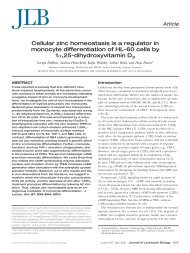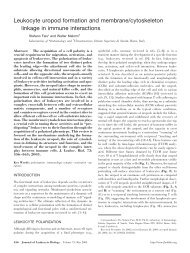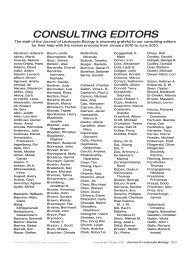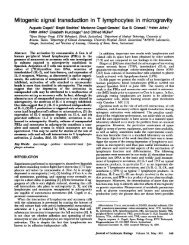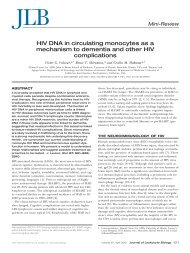Depletion of eosinophils in mice through the use - Journal of ...
Depletion of eosinophils in mice through the use - Journal of ...
Depletion of eosinophils in mice through the use - Journal of ...
You also want an ePaper? Increase the reach of your titles
YUMPU automatically turns print PDFs into web optimized ePapers that Google loves.
Fig. 5. Flow cytometry <strong>of</strong> N. brasiliensis (Nb) -<strong>in</strong>fected and -un<strong>in</strong>fected mo<strong>use</strong><br />
BAL sta<strong>in</strong>ed with FITC 6SH2-59. (A) Un<strong>in</strong>fected BALB/c, (B) Nb-<strong>in</strong>fected<br />
BALB/c, (C) May-Grünwald Giemsa-sta<strong>in</strong>ed, unsorted Nb-<strong>in</strong>fected BAL, (D)<br />
FACS-sorted CCR3-positive Nb-<strong>in</strong>fected BAL. The CCR3-positive sta<strong>in</strong><strong>in</strong>g<br />
cells represents a pure population <strong>of</strong> <strong>eos<strong>in</strong>ophils</strong>.<br />
polarized Th1 and Th2 populations, CD4 � and CD8 � T cells,<br />
and Y3 showed no appreciable CCR3 message, however, <strong>the</strong><br />
Y3/mCCR3-transfected cell l<strong>in</strong>e produced an easily detectable<br />
band (Fig. 6A). In a separate Nor<strong>the</strong>rn experiment, CCR3<br />
mRNA was not detected <strong>in</strong> rest<strong>in</strong>g or activated 3� polarized<br />
Th1 or Th2 cells. As a more sensitive assay <strong>of</strong> CCR3 mRNA, a<br />
quantitative RT-PCR analysis was performed with samples <strong>of</strong><br />
some <strong>of</strong> <strong>the</strong> same mRNA preparations <strong>use</strong>d <strong>in</strong> <strong>the</strong> Nor<strong>the</strong>rn blot<br />
analysis. RNA from activated Th2 cells did <strong>in</strong>deed conta<strong>in</strong><br />
CCR3 mRNA, but <strong>the</strong> amounts were approximately 80-fold less<br />
than <strong>in</strong> a comparable sample from <strong>the</strong> Y3/mCCR3-transfected<br />
l<strong>in</strong>e (Fig. 6B). If CCR3 were expressed on <strong>the</strong>se two cells <strong>in</strong> a<br />
ratio similar to <strong>the</strong>ir mRNA content, it would be quite<br />
consistent with <strong>the</strong> differences <strong>in</strong> fluorescent sta<strong>in</strong><strong>in</strong>g and<br />
functional responses between <strong>the</strong>se two cell populations. In a<br />
separate RT-PCR analysis, us<strong>in</strong>g a higher cycle number, both<br />
nonactivated Th2 and activated Th1 populations appeared to<br />
express approximately 50-fold lower levels <strong>of</strong> CCR3 mRNA<br />
than did activated Th2 cells (Fig. 6C). This result could<br />
represent lower levels <strong>of</strong> CCR3 mRNA expression by all cells or<br />
<strong>the</strong> presence <strong>of</strong> a small number <strong>of</strong> activated Th2 cells <strong>in</strong> <strong>the</strong>se<br />
populations. As a control, PCR analysis <strong>of</strong> parallel samples <strong>of</strong><br />
all mRNAs without reverse transcription did not show <strong>the</strong><br />
CCR3 band, demonstrat<strong>in</strong>g that contam<strong>in</strong>at<strong>in</strong>g genomic DNA<br />
was not be<strong>in</strong>g detected <strong>in</strong> <strong>the</strong>se PCR assays. Whe<strong>the</strong>r <strong>the</strong> low<br />
level <strong>of</strong> expression <strong>of</strong> CCR3 mRNA reflects a similar low level<br />
<strong>of</strong> surface CCR3 expression on <strong>the</strong>se cells is not yet known, but<br />
<strong>the</strong>se data make clear that, <strong>in</strong> <strong>the</strong> mo<strong>use</strong>, CCR3 expression is<br />
not a <strong>use</strong>ful basis for dist<strong>in</strong>guish<strong>in</strong>g Th2 cells from o<strong>the</strong>r T<br />
cells.<br />
Some anti-mCCR3 mAbs can specifically deplete<br />
<strong>eos<strong>in</strong>ophils</strong> <strong>in</strong> vivo<br />
Three anti-CCR3 mAbs were chosen for <strong>in</strong> vivo studies:<br />
6SH2-59 (IgG2a), 6SH2-88 (IgG2b), and 6S2-19-4(IgG2b).<br />
IgG2b is <strong>the</strong> most efficient complement-fix<strong>in</strong>g rat IgG subclass<br />
and it had been previously demonstrated that <strong>the</strong> rat IgG2b<br />
anti-mo<strong>use</strong> Ly-6G antibody, RB6-8C5, could be <strong>use</strong>d to<br />
specifically deplete <strong>eos<strong>in</strong>ophils</strong> and neutrophils <strong>in</strong> vivo [25]. To<br />
test whe<strong>the</strong>r anti-CCR3 mAbs <strong>of</strong> <strong>the</strong> IgG2b subclass could be<br />
<strong>use</strong>d to specifically deplete <strong>eos<strong>in</strong>ophils</strong> <strong>in</strong> a similar manner, N.<br />
brasiliensis-<strong>in</strong>fected <strong>mice</strong> were <strong>in</strong>jected with 0.5 mg <strong>of</strong> 6S2-<br />
19-4 or 6SH2-88. For comparison, o<strong>the</strong>r groups were <strong>in</strong>jected<br />
with <strong>the</strong> IgG2a anti-CCR3 mAb 6SH2-59 or <strong>the</strong> IgG2b<br />
anti-Ly-6G mAb, RB6-8C5. Blood <strong>eos<strong>in</strong>ophils</strong> were counted<br />
before and after adm<strong>in</strong>istration <strong>of</strong> <strong>the</strong> mAbs. Both <strong>of</strong> <strong>the</strong> IgG2b<br />
anti-CCR3 mAbs, 6S2-19-4 and 6SH2-88, depleted <strong>the</strong> circulat<strong>in</strong>g<br />
<strong>eos<strong>in</strong>ophils</strong> to below <strong>the</strong> levels <strong>of</strong> un<strong>in</strong>fected <strong>mice</strong> with<strong>in</strong><br />
24 h and <strong>the</strong>se levels rema<strong>in</strong>ed low for at least 7 days (Table 1).<br />
In subsequent experiments, as little as 100 µg <strong>of</strong> ei<strong>the</strong>r mAb<br />
gave maximal depletion <strong>of</strong> <strong>eos<strong>in</strong>ophils</strong> at <strong>the</strong> 24 h time po<strong>in</strong>t. In<br />
contrast, no significant depletion was observed with <strong>the</strong> IgG2a<br />
anti-CCR3 mAb 6SH2-59. Differential blood smears showed<br />
that <strong>the</strong> IgG2b anti-CCR3 mAbs depleted <strong>eos<strong>in</strong>ophils</strong>, but not<br />
neutrophils (data not shown), whereas <strong>the</strong> RB6-8C5 mAb<br />
depleted both cell types [25].<br />
Repeated anti-mCCR3 mAb treatment can<br />
partially deplete <strong>eos<strong>in</strong>ophils</strong> <strong>in</strong> N. brasiliensis<strong>in</strong>fected<br />
lung tissue and BAL fluid<br />
In <strong>the</strong> experiments discussed above, relatively little eos<strong>in</strong>ophil<br />
depletion was observed <strong>in</strong> <strong>the</strong> lung <strong>in</strong>filtrates or BAL <strong>of</strong> <strong>mice</strong><br />
given a s<strong>in</strong>gle <strong>in</strong>jection <strong>of</strong> anti-CCR3 mAb. To determ<strong>in</strong>e<br />
whe<strong>the</strong>r depletion <strong>in</strong> <strong>the</strong>se compartments would be more<br />
effective if begun at <strong>the</strong> <strong>in</strong>itiation <strong>of</strong> <strong>the</strong> <strong>in</strong>fection, <strong>mice</strong> were<br />
given 0.5 mg <strong>of</strong> 6S2-19-4 <strong>in</strong>traperitoneally 2 days before N.<br />
brasiliensis <strong>in</strong>fection and <strong>the</strong>n aga<strong>in</strong> on days 3, 8, and 11. Mice<br />
were killed on day 12 and <strong>the</strong> lungs, BAL fluid, and blood were<br />
collected for analysis. As expected, anti-CCR3 mAb-treated<br />
animals had low circulat<strong>in</strong>g eos<strong>in</strong>ophil levels comparable to<br />
un<strong>in</strong>fected control <strong>mice</strong> (data not shown). Total eos<strong>in</strong>ophil<br />
numbers <strong>in</strong> BAL fluid, as assessed by differential cell counts,<br />
were reduced from 3.55 � 10 6 � 1.42 � 10 6 <strong>in</strong> N. brasiliensis<strong>in</strong>fected<br />
<strong>mice</strong> to 1.07 � 10 6 � 0.46 � 10 6 <strong>in</strong> <strong>in</strong>fected,<br />
anti-CCR3-treated <strong>mice</strong> (n � 6 <strong>in</strong> each group). Anti-CCR3<br />
mAb treatment did not appear to deplete any cell type o<strong>the</strong>r<br />
than <strong>eos<strong>in</strong>ophils</strong> <strong>in</strong> ei<strong>the</strong>r blood or BAL cells. Paraff<strong>in</strong> sections<br />
<strong>of</strong> <strong>the</strong> lungs taken from animals treated with 6S2-19-4 showed a<br />
similar significant reduction <strong>in</strong> <strong>eos<strong>in</strong>ophils</strong>, <strong>in</strong> this case, to<br />
approximately 50% <strong>of</strong> that <strong>in</strong> <strong>in</strong>fected controls (data not shown).<br />
Thus <strong>the</strong> eos<strong>in</strong>ophil population <strong>in</strong> <strong>the</strong> lung tissue and BAL were<br />
partially protected from antibody-mediated kill<strong>in</strong>g. One possible<br />
explanation is that <strong>the</strong> expression <strong>of</strong> CCR3 on many<br />
Grimaldi et al. <strong>Depletion</strong> <strong>of</strong> mo<strong>use</strong> <strong>eos<strong>in</strong>ophils</strong> <strong>through</strong> <strong>the</strong> <strong>use</strong> <strong>of</strong> antibodies 851




